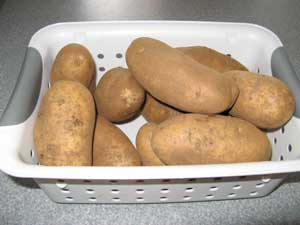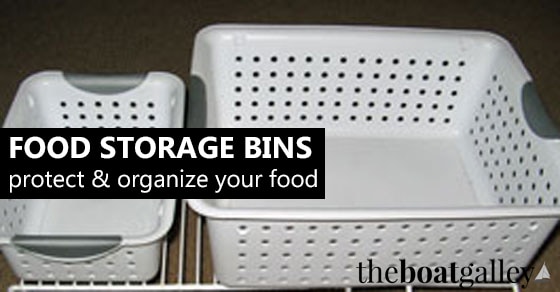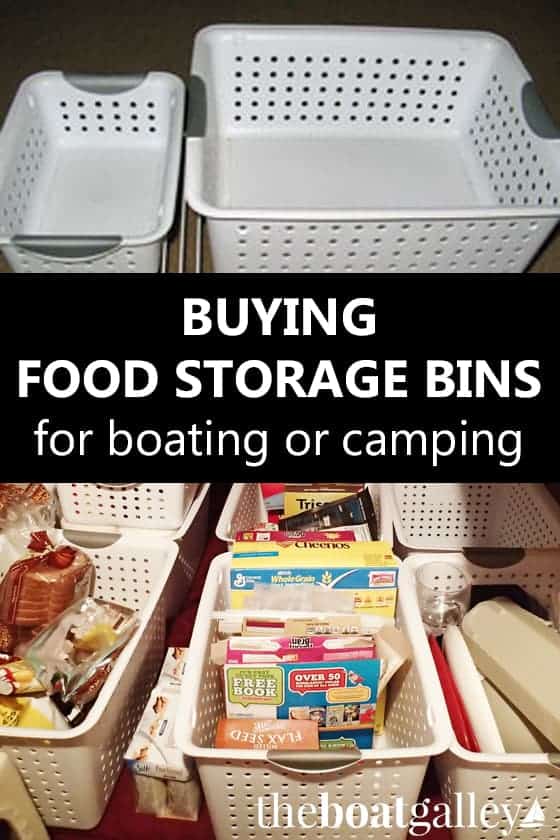I highly recommend using bins to organize lockers and your refrigerator. They’ll not only keep like foods together, but they’ll keep cans from rolling and packages from sliding . . . and, should anything break or leak, at least the mess will be contained.
What should you look for in your bins?
Size. Size is a two pronged question. First, will the bin fit where you want to put it? Not just will it fit in the locker (and through the locker opening), but will it fit tightly with other bins in the space? The tighter they fit together, the less they’ll slide when underway. This translates both to less noise and less chance of something being damaged.
Second, the bin has to be properly sized for whatever you want to put it it. You’ll need a combination of larger and smaller bins, shorter and taller.
Ventilated or Not. For most items, I prefer ventilated bins so that there is some airflow around whatever is being stored. In lockers, this will result in less mold and spoiled food, particularly for produce. Other food containers will also benefit from air circulation, too.
In the refrigerator/freezer/cooler, air flow and ventilated containers are essential to allow the cold air to reach the food. While solid containers will eventually get cold, using them will result in uneven cooling.
There were a few times that I could not find a ventilated bin that fit a space. I soon learned that I could add air holes to most solid bins — and I learned that it was a LOT easier to make “squarish” holes with a Dremel tool than try to use a drill on plastic!
 Solid Bottoms. Regardless of whether the item needs a ventilated bin, solid bottoms are a real must, for several reasons:
Solid Bottoms. Regardless of whether the item needs a ventilated bin, solid bottoms are a real must, for several reasons:
- Openings in the bottom will bruise produce and can tear open bags and other containers with the motion of the boat;
- If water (or anything else) gets into the locker, a solid bottom will provide much better protection against damage to the bin contents.
- And if anything leaks, breaks or rots, a solid bottom (and 1″ of solid material on the sides) will ensure that the mess stays in the one bin.
Plastic. Plastic bins are easy to clean and can be quickly sterilized with a bit of bleach water.
Shape. While the height of the bins will be determined by the space available and what you’re planning to store in the bin, virtually all storage spaces have square corners. And therefore, square or rectangular bins make the best use of the space.
Handles. Handles are nice on bins that you move around frequently, but they do take up space. Unfortunately, the reality is that it’s very hard to find bins that don’t have handles.
Lids. I only used lids in three instances:
- Places where there might be a leak from above (such as a locker right under the chain plates);
- Bins placed in open areas, such as on the quarterberth. This kept dust from collecting in the bin and also looked neater.
- Where I wanted to put another bin on top of the one below. Open stacking bins generally don’t stay put with the motion of the boat, and the top bin will tend to have one side fall into the bin below if you don’t use lidded bins.
Rugged Construction. How sturdy the construction has to be depends somewhat on what you’re going to store in the bin. For example, a bin holding canned food is very susceptible to damage as the cans rock or slide with the motion of the boat. Bins that you frequently move to get to something underneath them, as well as bins with another bin on top are more likely to crack. And bins that are overcrowded will easily break. In these situations, heavy duty bins will really pay off in the long run.
If you’re starting with an “empty” boat, it can be a daunting task to find all the bins you need. And good ones aren’t cheap! However, I learned my lesson that trying to get by with fewer bins, and buying lower quality ones, just didn’t work. I lost several bags of flour that split after sliding in the locker on an overnight passage (the motion chafed through both the outer plastic bag and the inner paper bag). On that same trip, canned vegetables cracked a lightweight bin.
Further, if you’re planning to cruise outside the US, it can be difficult to find high-quality bins in other countries. Where we were cruising in Mexico, I could find plenty of less ruggged containers, as well as lots of very large solid bins. But I never found the high quality organizing bins that I could get in the US, and so I ended up making do, holding broken containers together with duct tape and using waste baskets with holes cut in them.
Luckily, when we had first moved aboard I had bought a bunch of Sterilite bins (without lids) and had used them to transport things to the boat, then used them in the boat. I quickly learned that they were cherished possessions! The previous owner had also left a couple of really good Rubbermaid bins. I highly recommend either of these — most of the other brands I’ve had a chance to look at recently just aren’t as good . . . but you may find something that I haven’t seen.
While many of these bins are available at Wal-mart and Target, here are links to them on Amazon so that you can see the styles I like (sometimes Amazon’s prices are better than local stores, sometimes not):
- Sterilite “Ultra Basket” ventilated bins
- Sterilite Storage Boxes and Totes (not ventilated)
- Rubbermaid Roughneck Boxes (not ventilated — we used these to hold cans of soft drinks)
Wire bins don’t work for most items — they create pressure spots along the wires. Ventilated “milk crates” also tended to have pressure points from the ridges (and most have open bottoms). For small, lightweight items — particularly in small lockers — I successfully used rectangular juice bottles with the tops cut off and the cut edge reinforced with duct tape.

Carolyn Shearlock has lived aboard full-time for 17 years, splitting her time between a Tayana 37 monohull and a Gemini 105 catamaran. She’s cruised over 14,000 miles, from Pacific Mexico and Central America to Florida and the Bahamas, gaining firsthand experience with the joys and challenges of life on the water.
Through The Boat Galley, Carolyn has helped thousands of people explore, prepare for, and enjoy life afloat. She shares her expertise as an instructor at Cruisers University, in leading boating publications, and through her bestselling book, The Boat Galley Cookbook. She is passionate about helping others embark on their liveaboard journey—making life on the water simpler, safer, and more enjoyable.
Simplify meal prep on board with proven strategies for provisioning, maximizing fridge space, and cooking delicious meals aboard your boat.










nichola wright says
Hi, great articles you write full of useful tips.
we live aboard in the UK and have very few places on the boat that don’t suffer some dampness due to condensation. For those with similar problems I thought I’d give our solution to get round this. I’ve used the round, watertight storage kegs shown here:
https://www.solentplastics.co.uk/marine-storage-products-boxes/waterproof-and-airtight-kegs-drums/
The 10 litre one stands upright and fits in the locker under our bench seat. I then fill them with big bags of food and keep a smaller tub in a galley locker that I can decent into. For example a 5kg bag of rice goes into a keg with a cereal dispenser type tub in the galley. Similarly for pasta, cereal and flour. The kegs are round so don’t make the best use of space but I just stick a plastic bottle of juice in the gap left between the kegs.
Norm Pettett says
Cardboard?
The Boat Galley says
Now that I know what size bins fit, the next step will be getting Lock & Locks that fit in them and then I’ll be able to get rid of the carrdboard. Good eye!
Norm Pettett says
Thank you! I thought I read that chapter wrong. I get rid of all the cardboard and pasteboard. Whew!
The Boat Galley says
We’ve been getting rid of a lot, just not quite all yet. And I guess most that remains IS in that picture!
Beth Tyler says
we have the same bins under the seatee
The Boat Galley says
I love these. Solid bottoms in case anything spills, but otherwise ventilated.
Behan Gifford says
these are great. to REALLY be my ideal, they would also be stackable- seen anything like that Carolyn?
The Boat Galley says
Behan – I haven’t, but I’ll keep my eye out . . . I’d like some too!
Beth B says
Found something similar at Walmart too, as another reader noted. The baskets look almost exactly like the Sterilite ones, but the construction is more sturdy and the handle grips flip up so you can stack them easily. And they cost about half as much as the Sterilite kind. Come in three sizes. The smaller one is actually short enough to fit on a narrower shelf. We use those for stackable “drawers” in the head when we have guests on the boat. Am also using a couple of the smaller baskets in the galley, and one is keeping small gear in place at the helm station. The large size is holding diving gear in a rear compartment. Love these vented baskets!
Connie Lacelle says
LOVE these bins. Makes me want to run right out and buy some! I do prefer stackable–bought some several years ago but I don’t remember where and don’t know if they can still be had. Regarding these ones in the picture, I like the idea of their breathability and that you can put chains in the holes to hang them.
Nancy Maurer Rieckmann says
I know some of you ladies were looking for vented plastic baskets that stacked. I found these at Wal Mart. Looks like a regular handle but it flips in to hold the next basket.
Lamarr Harding says
I’ve cut rectangular plastic juice jugs to the height needed, put a bead of silicone adhesive in the bottom and let it cure upside down. The rubbery goo on the bottom retards movement, and the clear plastic let’s you see inside.
For my plastic totes clear resin saves opening and retaking to find something.
Cory Nickerson says
Timely article…. provisions all bought, here’s my cockpit.
Debbie Bowen Crawford says
The galley has been my struggle.
The Boat Galley says
You might get some ideas from this article: https://theboatgalley.com/real-life-galley-storage/ and there are a lot more ideas and tips here: https://theboatgalley.com/tag/food-storage/
Debbie Bowen Crawford says
Your book has been a huge help. I have a hard tme getting on my knees to see what is in the lockers so I am know hanging labels on the outside. Living aboard is just a period of adjustment and I am still adjusting 18 months later. I am now taking stuff off the boat I am not using and occasional stuff is in a tote in the egine room with a lid and out of my way.
Barbara Hart says
Great article. Before we crossed from St. Maartin in 2014 I found two small plastic baskets in the office section of the hardware store on the Dutch side. Each held a bag of granny smith apples — just. They fit in two corners under out galley sink, but the apples would have rolled all over underway. I took netting and small shock cord and wove the shock cord through the basket and the netting, creating a semi-tight lid. We had no rotting apples rolling around under the sink. For the win.
Debbie Bowen Crawford says
We have a 1974 marine Trader and have found Rubbermaid storage bins that fit in our locker perfect and they have a track that they sline in and out on. I have asked the husband for 8 more so I will have one in all my galley lockers.They are a perfect fit.
The Boat Galley says
How lucky to find ones that fit perfectly and are tough!
Dave Alexander says
Check for a Forstner bit at the hardware store. They aren’t overly expensive, but they have a very sharp pilot. They use a small pilot in the center, first, then a big circle cutter. The pilot won’t slide on plastic, but the bit will make nice big holes.
Anonymous says
Julie Kapferer Bednar
Ann says
What about using bamboo or wicker baskets? I was thinking about making a hanging tiered fruit/ veggie unit with a plastic lining so it could be cleaned. It would look so much nicer than plastic!
Carolyn Shearlock says
Bamboo and wicker are a lot harder to keep clean — they really collect dust in the nooks and crannies, regardless of the lining. But if you’re willing to deal with it, sure.
Kathy Kantel says
I wish I could find sturdy, straight sided bins so that tight space doesn’t get wasted.